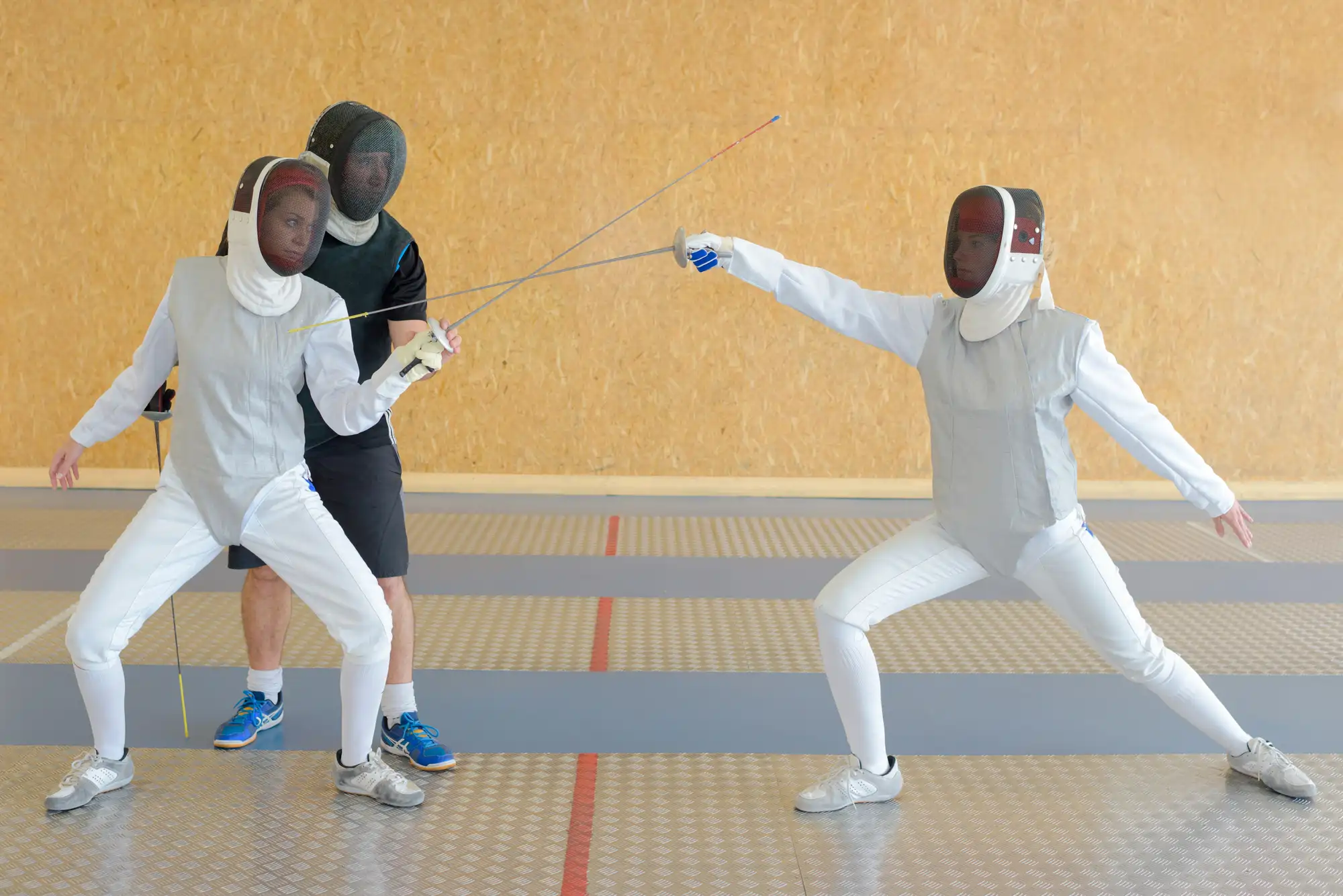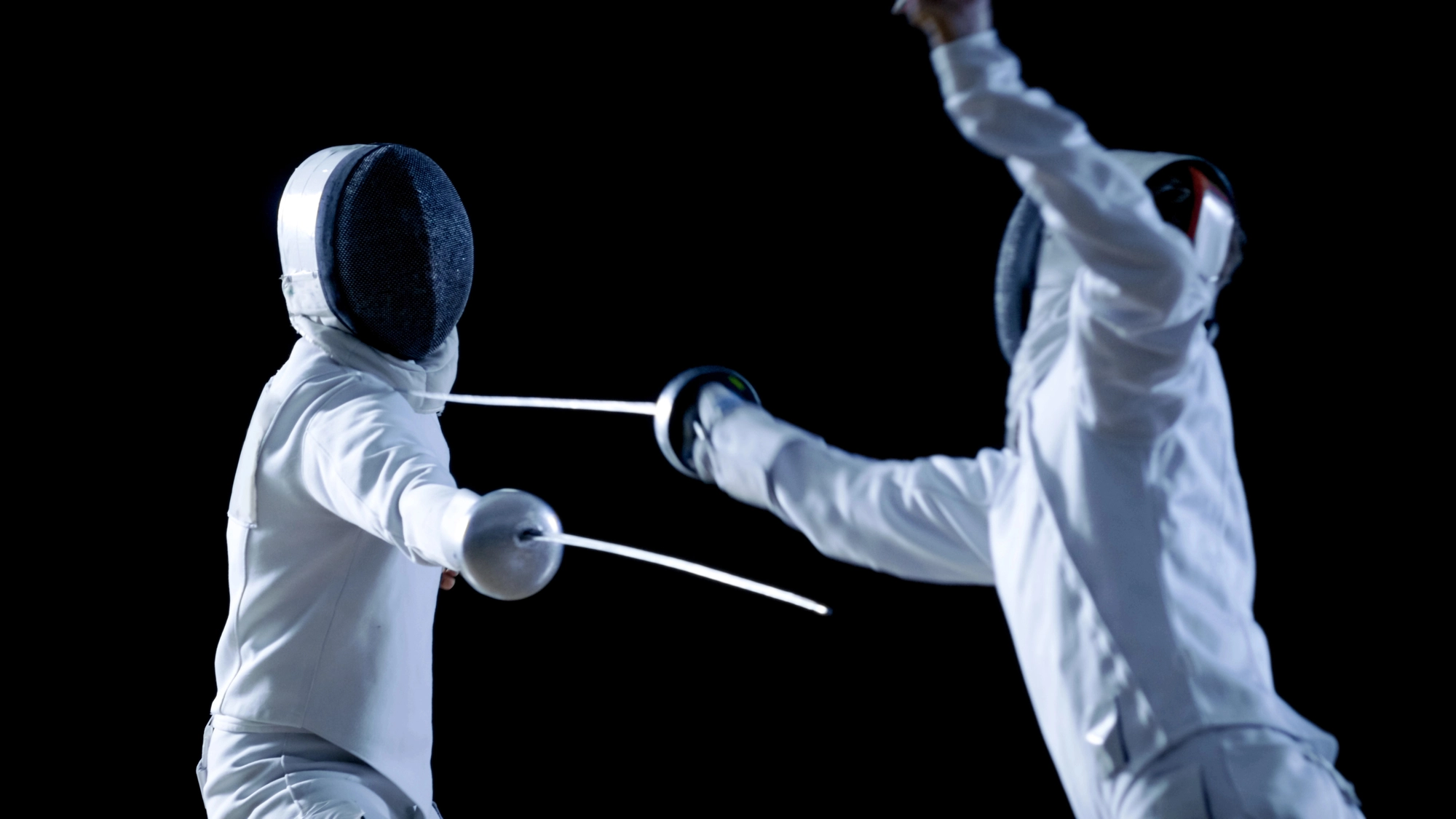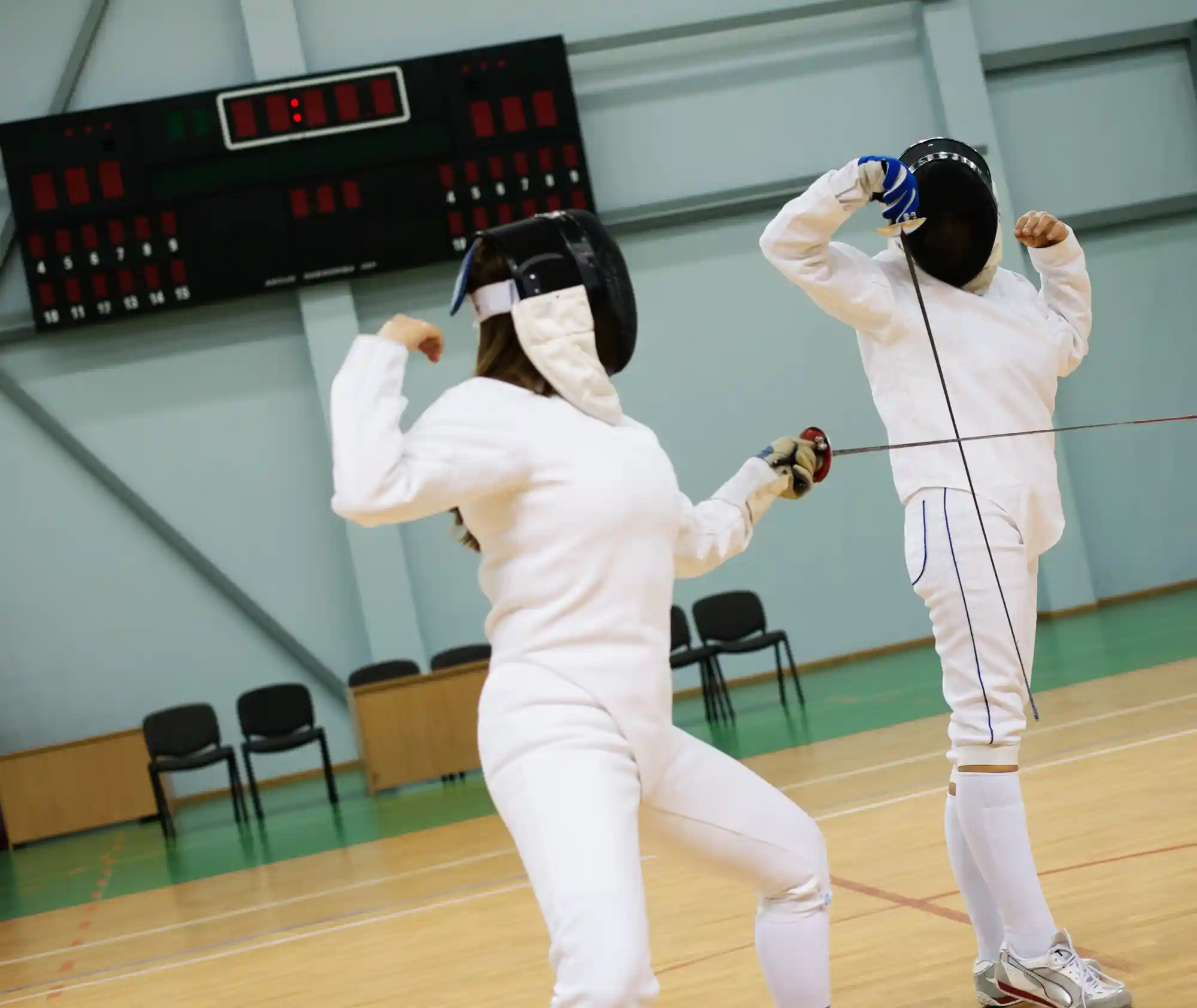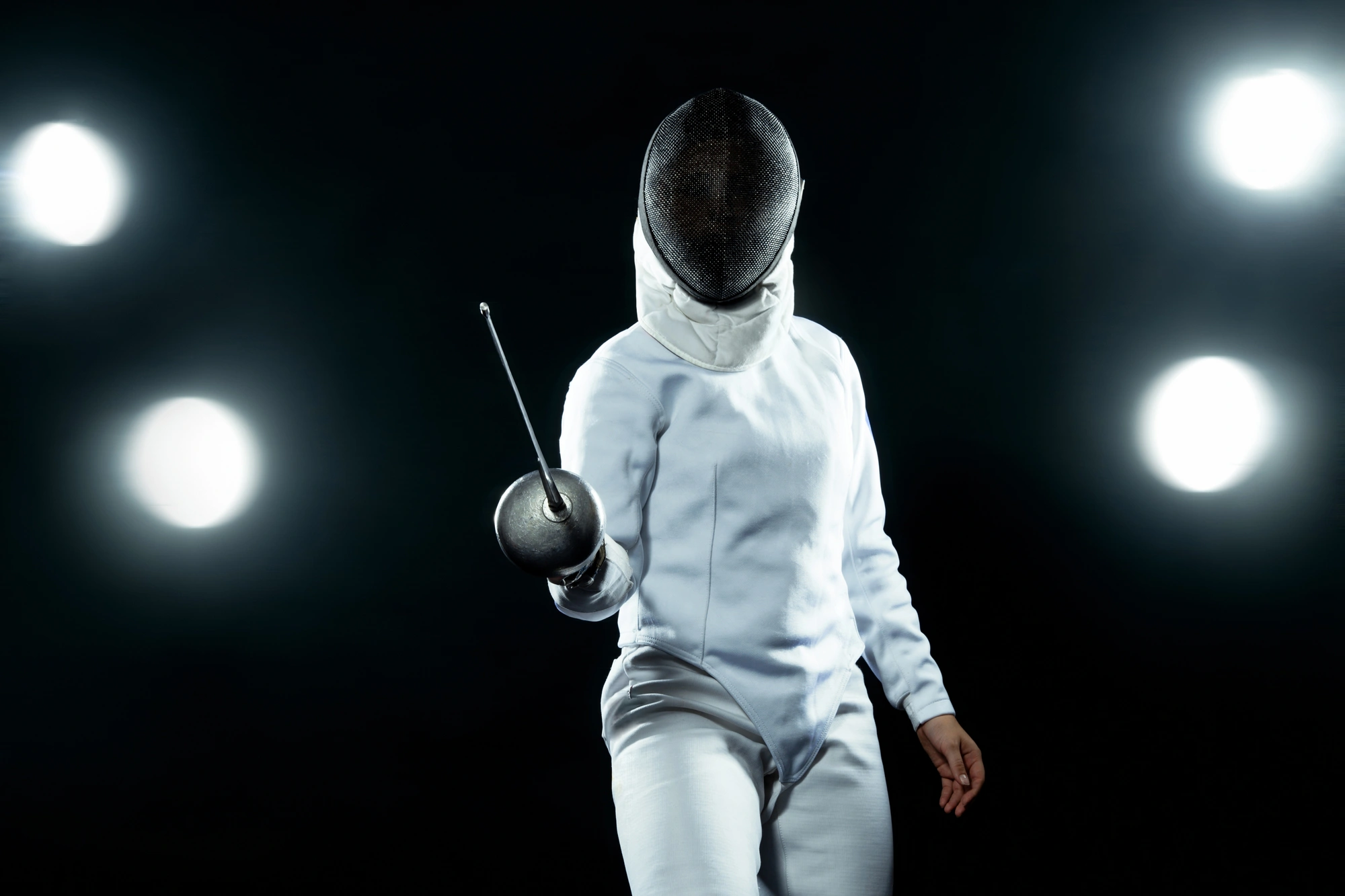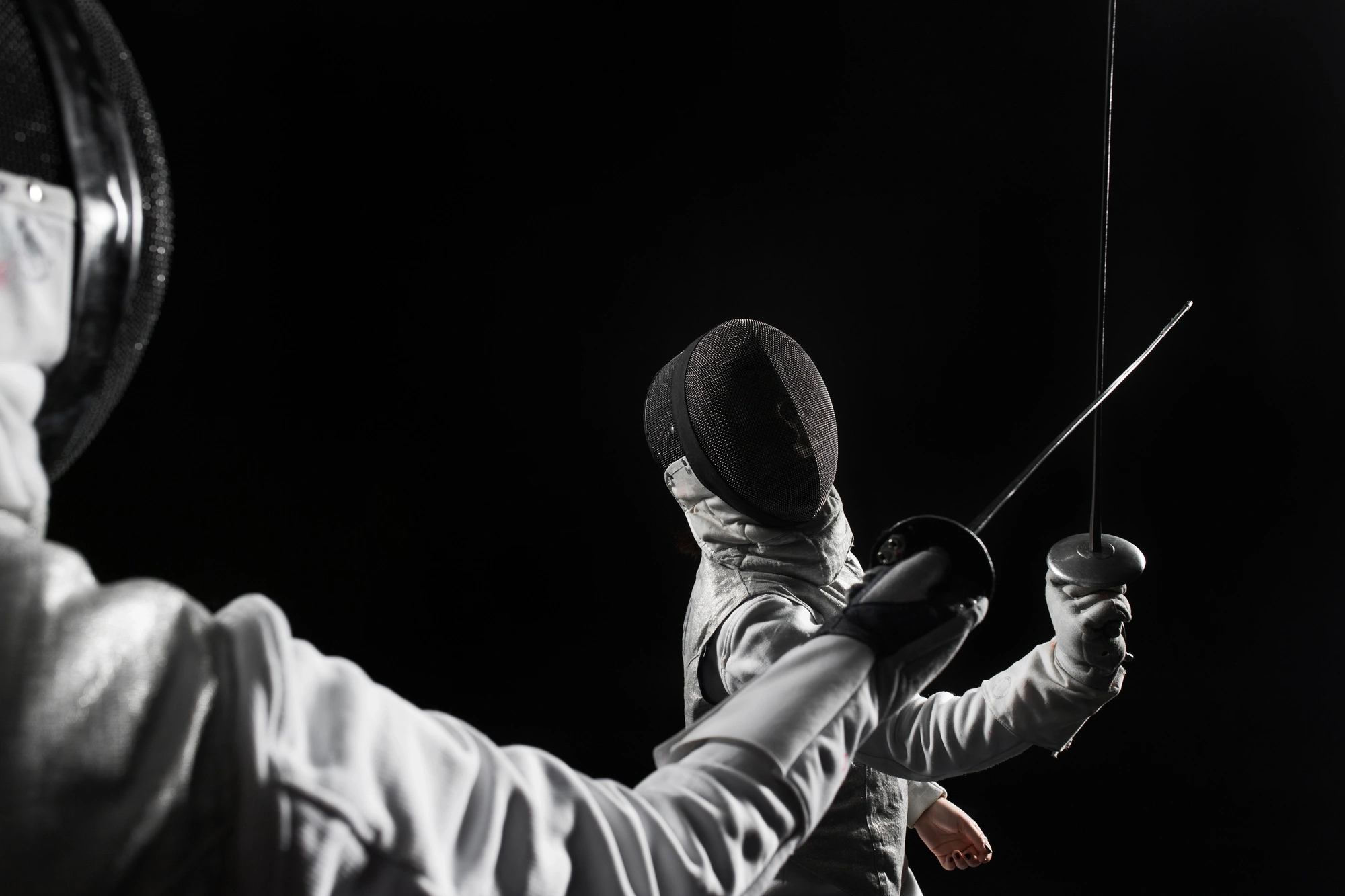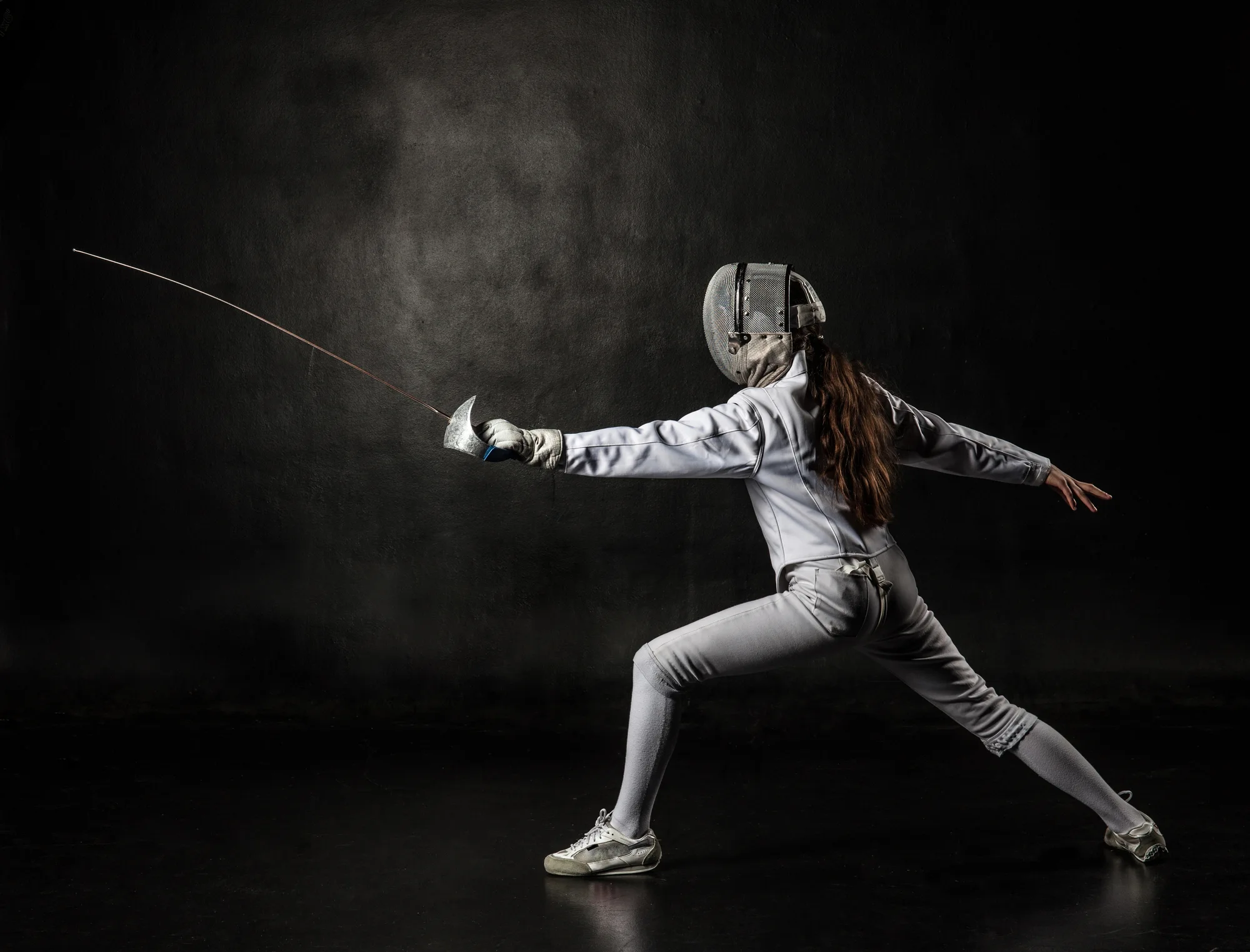We may earn revenue from the products available on this page and participate in affiliate programs. Learn more >
Fencing, with its roots in ancient swordsmanship, is one of the most timeless and thrilling sports. For centuries, warriors and nobles honed their skills with the blade, mastering the art of the duel.
As one of the main sports inspired by swords, fencing combines strategy, athleticism, and grace, offering a unique and engaging experience. In this guide, we’ll explore the rich history of fencing, delve into the essential equipment, and break down the techniques that make this sport so captivating.
What is Fencing?
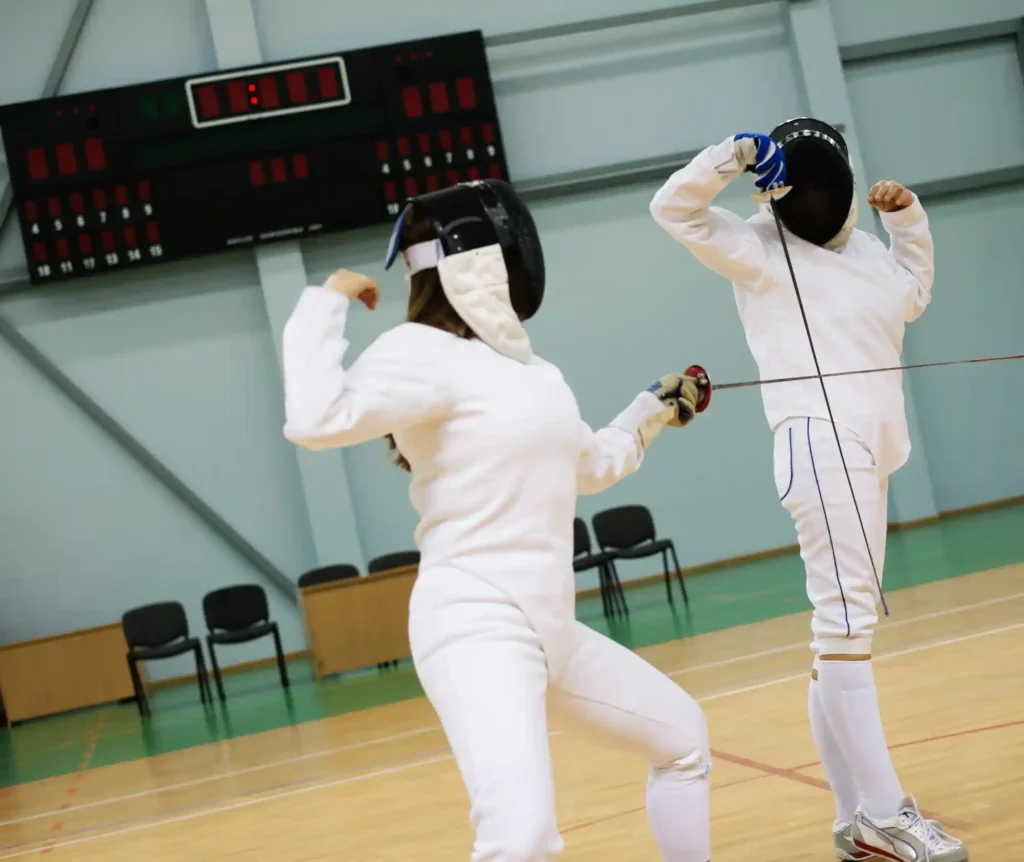
Fencing is a sport where two people face off with swords. In fencing, you score points by touching your opponent with your sword. They wear protective gear and use blunt weapons, so it’s safe.
There are three main types of fencing, each named after the type of sword used: foil, epee, and sabre. Each discipline has its own rules and style, but they all involve quick movements, smart tactics, and good reflexes.
A Brief History of Fencing
Fencing has its roots in ancient civilizations but truly took shape in medieval Europe, where knights and nobles trained for real combat. The Renaissance refined the art with Italian masters developing the rapier, a weapon that introduced a focus on thrusting techniques and personal dueling. By the 17th century, France’s lighter smallsword led to a more elegant style.
The 18th and 19th centuries saw fencing evolve into a sport, with standardized rules and the formation of clubs. Making its Olympic debut in 1896, and included all three weapons by 1908. The 20th century introduced electric scoring for accurate judging.
Women’s participation in the sport expanded significantly, with foil being added to the Olympics in 1924, epee in 1996, and sabre in 2004.
Why is Called Fencing
Ever wondered why we call it “fencing”? The word “fence” comes from the old word “defens,” which means defense or protect. Over time became associated specifically with sword fighting as a sport. The name stuck because the activity involves both defending yourself and attacking your opponent with a sword.
The Three Sword Types
| Feature | Sabre | Foil | Epee |
| Blade length | max 105 cm | max 110 | max 110 cm |
| Weight | max 500 gr | less than 500gr | less than770 |
| Target Area | Head, Torso, Upper Arm | Torso Only | Whole Body |
| Scoring Method | Tip & Edge | Tip Only | Tip Only |
| Right of Way | Yes | Yes | No |
| Play Style | Fast, Agile | Precise, Technical | Strategic, Patient |
Foil
Foil is often considered the foundation of modern fencing. It uses a light, flexible weapon with a small bell guard. The target area is restricted to the torso, including the back, but not the arms or head.
This limitation stems from its origins as a training tool for dueling, where the aim was to target vital organs. Points are scored only with the tip of the blade.
One of the key aspects in this discipline is the concept of “right-of-way” or priority.
Right of way decides who gets the point if both fencers hit at the same time. The fencer who attacks first has priority. If that attack is blocked or misses, the opponent can counter-attack and gain priority.
Epee
Derived from the French word for sword, is closest to actual dueling. It uses a heavier weapon with a larger bell guard. The entire body is a valid target, from the toes to the top of the head.
Like foil, points are only scored with the tip, but the lack of right-of-way rules makes epee unique. The first fencer to land a hit scores, regardless of who initiated the attack.
This leads to a more cautious, defensive style of fencing, where patience and timing are crucial. Double touches are allowed, meaning both fencers can score if they hit within 40 milliseconds of each other.
Sabre
Evolved from cavalry sword fighting, this discipline is the most dynamic and fast-paced of the three, allowing hits with both the tip and the edge of the blade.
The target area includes everything above the waist. Sabre has right-of-way rules, but the ability to score with slashing movements makes for lightning-fast exchanges.
Basic Equipment: What You Need to Start
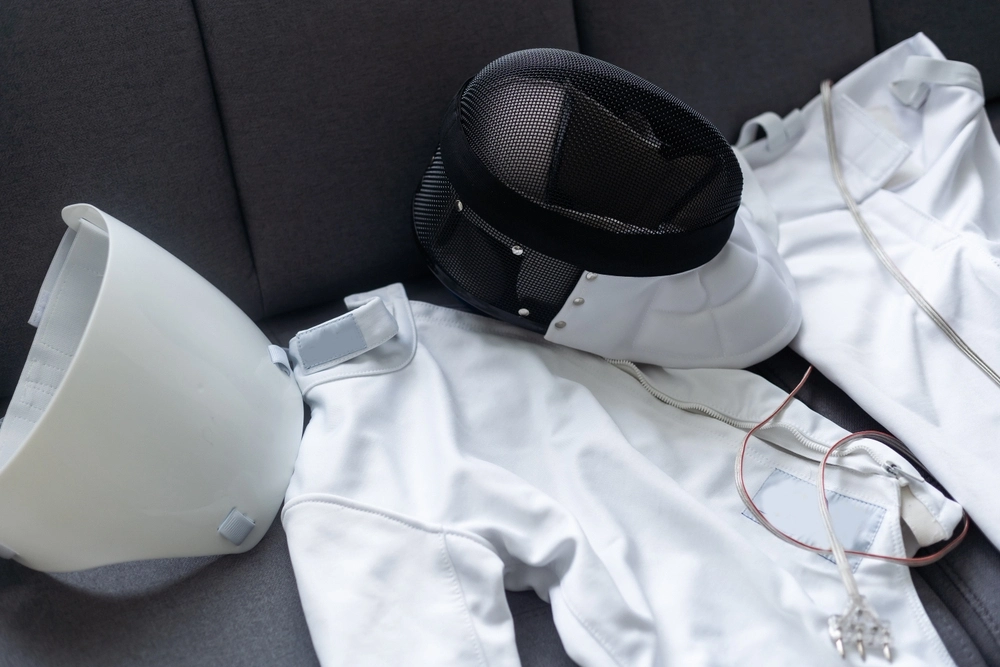
Fencing doesn’t require a ton of gear, but what you do need is important for both safety and performance. Here’s the essential equipment for beginners.
1. Fencing Sword
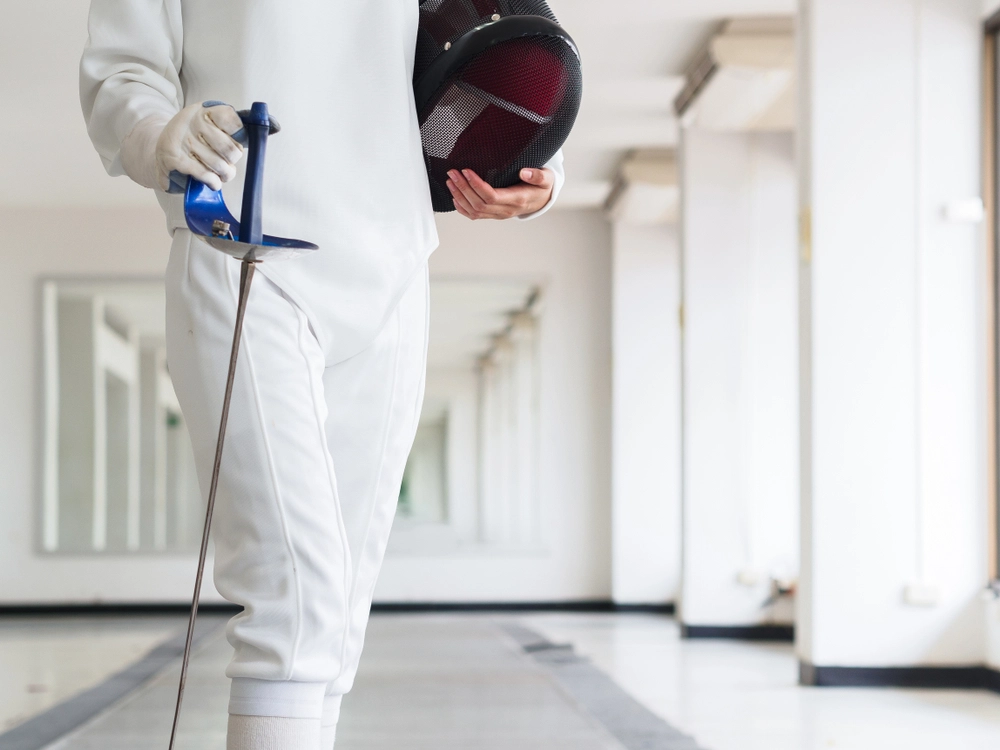
Weapon is the key choice for beginners. You have three options: 1. Foil for light and flexible, 2. epee is heavier and patient, 3. sabre if you want quick and aggressive. Most clubs let you try all three, so you can find which suits you best before committing.
2. Mask
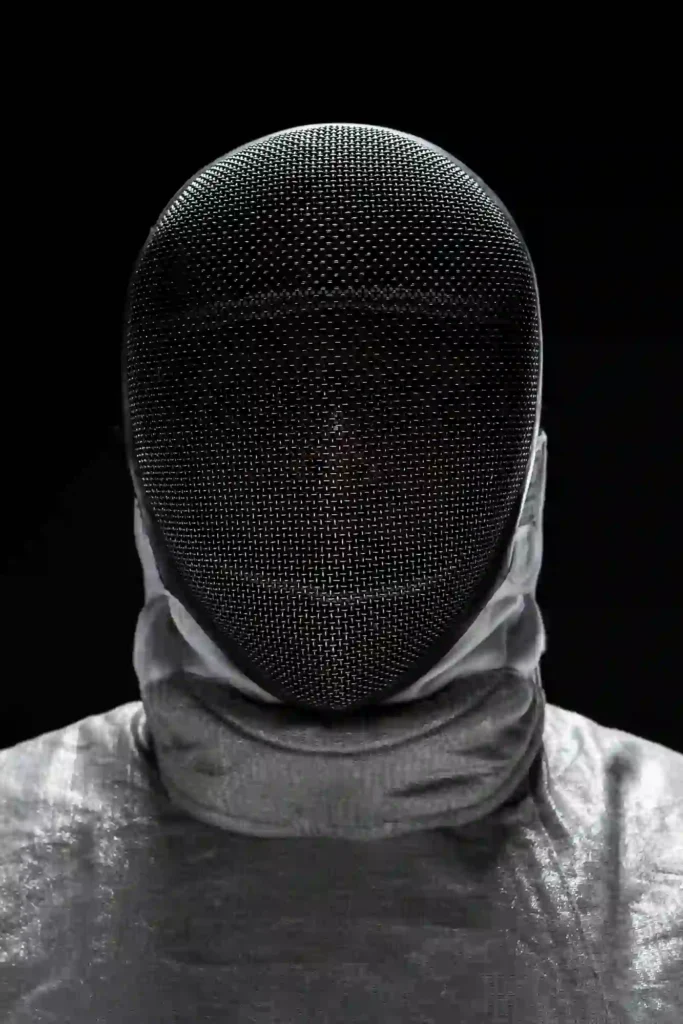
The mask is a crucial piece of gear in fencing. It protects your face and head from strikes, featuring a sturdy mesh front for visibility and breathability. The bib extends down to cover the neck, adding an extra layer of protection.
3. Lame
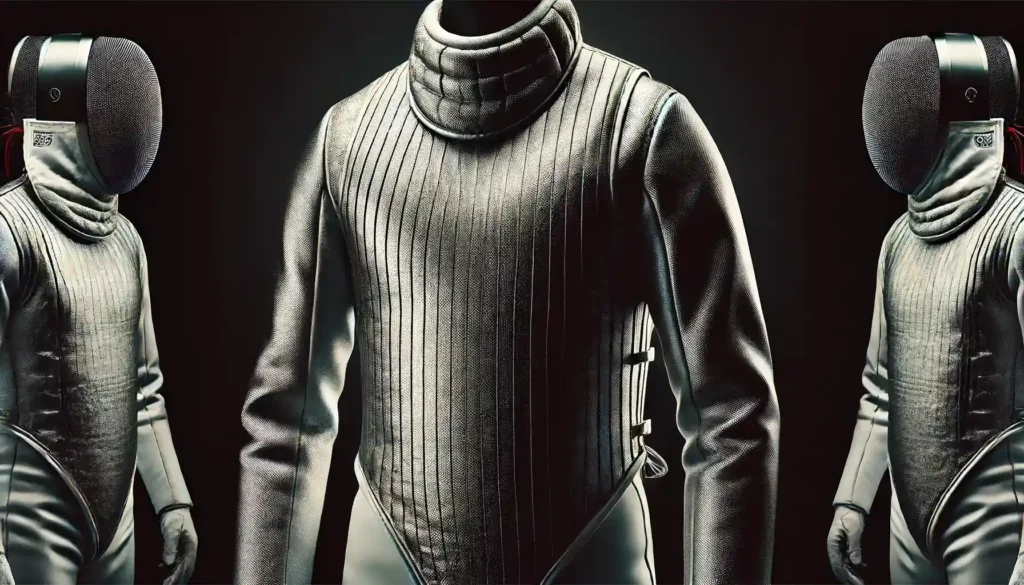
Jacket (Lame) is a metallic jacket that covers your torso, designed to register hits in electronic scoring. It also offers protection against the blade.
4. Gloves
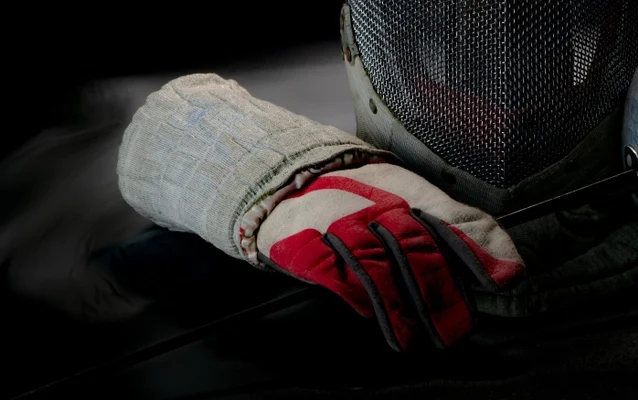
Gloves are important to worn because they will protect you from hits and provide a better grip. It should be padded and fit well to allow full movement.
5. Shoes, Socks, and Pants

For competitions, fencers must wear specially designed pants, often called breeches, which extend just below the knee. These pants are padded for extra protection and durability.
Long, knee-high socks cover the rest of the leg to ensure no skin is exposed. Fencers use specific shoes that are lightweight with a flat sole to provide better grip and stability.
Most beginners start with non-electric gear and progress to electric scoring systems later. Many clubs provide basic equipment for newcomers, so you might not need to buy everything right away.
Weapon grip,
Foil and epee come with two grip styles. The first is the traditional French grip, commonly used by beginners and for practice. The second is the pistol grip, which was developed in Italy. It’s important to note that there is no such thing as a pistol grip for sabres.
Fencing Terms You Will Hear
Fencing has its own unique vocabulary. Here’s a quick rundown of key terms you’ll hear.
| Term | Definition |
|---|---|
| En garde | The starting position for fencers. |
| Piste | The strip where fencing takes place. |
| Lunge | A forward thrust to attack your opponent. |
| Parry | A defensive move to block an attack. |
| Riposte | A counterattack after a successful parry. |
| Touché | French for “touched,” used to acknowledge a hit. |
| Bout | A fencing match. |
| Foible | The weaker part of the blade near the tip. |
| Forte | The stronger part of the blade near the handle. |
| Advance | A step forward. |
| Retreat | A step backward. |
| Feint | A fake attack to mislead your opponent. |
| Flèche | A running attack. |
| Balestra | A jump forward, usually followed by a lunge. |
| Corps-à-corps | When fencers come into physical contact. |
| Priority | Also called right-of-way, determines which fencer scores in simultaneous hits. |
| Remise | A quick, repeated attack. |
| Disengage | A circular motion of the blade to avoid an opponent’s parry. |
| Appel | A stamp of the front foot to distract or intimidate the opponent. |
| Allez | French for “go,” used by the referee to start or resume a bout. |
| Halt | Command to stop the action. |
| Counter-attack | An attack made during the opponent’s offensive action. |
| Passata sotto | A defensive action where the fencer drops under the opponent’s blade. |
| Reprise | Renewal of an attack that missed or was parried. |
| Beat | A sharp tap on the opponent’s blade to open a line for attack. |
| Compound attack | An attack with one or more feints before the final action. |
| Double | When both fencers score a hit simultaneously. |
| Extension | Stretching out the sword arm before a lunge or attack. |
| Measure | The correct distance between fencers to land a hit. |
| Phrase | A set of offensive and defensive actions in a fencing exchange. |
| Octave | The eighth parry, protecting the low outside line. |
| Septime | The seventh parry, protecting the low inside line. |
| Sixth | The sixth parry, protecting the high outside line. |
| Quarte | The fourth parry, protecting the high inside line. |
| Second | The second parry, protecting the low outside line, also known as “two.” |
| Tierce | The third parry, protecting the high outside line. |
| Line | The area of target exposed to an opponent. |
| Counter-parry | A parry followed by another parry in a different line. |
| In Quartata | A counter-attack made while twisting the body to avoid the opponent’s blade. |
| Stop-Hit | A counter-attack made just before the opponent’s final action. |
| Time-Hit | A counter-attack with opposition, taking time to intercept the opponent’s blade. |
| Opposition | Using the blade to control the opponent’s blade during an attack or defense. |
| Redouble | A second attack after the first has been parried, without withdrawing the arm. |
| Touch | A point scored in fencing. |
| Guard | A defensive position or stance. |
| Engagement | When the blades are in contact and exert pressure on each other. |
| Flick | A whipping attack made with a flexible blade. |
| Plastron | A protective underarm garment worn beneath the jacket. |
| Absence of blade | When neither fencer’s blade is in contact with the other’s. |
These terms come up often in fencing. Knowing them helps you understand the sport better, whether you’re fencing or watching.
Master Rules and Scoring
Fencing matches, or bouts, are pretty simple once you understand the basics.
Competitors engage on a narrow strip called a piste, aiming to score either 5 or 15 points based on the competition level. Matches are time-bound, with a limit of 3 minutes for 5-point bouts and 9 minutes for 15-point bouts.
Most competitions use electronic scoring, with participants wearing special gear that registers hits. In foil and sabre, only one competitor can score at a time due to right-of-way rules. In epee, both competitors can score if they hit nearly simultaneously.
If time runs out, the highest score wins. Ties go to sudden death. There are penalties for things like stepping off the piste too much or unsportsmanlike conduct. A referee oversees the bout and makes final decisions.
For beginners, non-electronic scoring is common, with judges watching for hits.
Basic Techniques and Strategies
Fencing is all about outsmarting your opponent. Effective techniques and strategies are key to success.
Footwork is crucial. The advance, retreat, and lunge form the foundation of movement on the piste. Mastering these allows you to control distance effectively.
Point control is essential in all weapons. Practice hitting small targets to improve accuracy.
Parries are defensive moves to block attacks. There are eight standard parries, each covering a different area.
Ripostes, or counterattacks after a parry, are a great way to score. The key is to make them quick and direct.
Feints, or fake attacks, are used to draw a reaction from your opponent. Use these to set up real attacks.
Distance management is critical in all weapons. Learning to stay just out of your opponent’s range while keeping them in yours is a fundamental skill.
Combining techniques is where strategy really comes in. A feint followed by a disengage, or a parry-riposte combination, can be highly effective.
Remember, these are just basics. As you progress, you’ll develop your own style and preferred techniques. The best strategy is often the one your opponent least expects.
Physical and Mental Benefits
Fencing offers a unique blend of physical and mental perks. It’s a full-body workout that boosts cardio, builds leg strength, and improves flexibility and coordination.
The sport helps relieve stress and builds confidence as you master new skills. Plus, it’s great for social connections, teaching sportsmanship and providing a welcoming community.
Whether you’re looking to get fit, challenge your brain, or meet new people, is a good option. And the best part? It’s a lifetime sport, accessible to all ages.
Getting Started: How to Find Classes or Clubs
Ready to try? Here’s how to get started:
Local clubs are your best bet. Most cities have at least one. Search online for “fencing clubs near me” or check your national fencing association’s website for listings.
Community centers sometimes offer introductory classes. These can be a low-pressure way to try the sport. Equipment stores often know about local clubs. Give them a call and ask for recommendations.
Look for “open fencing” nights at clubs. These sessions let you try without committing to regular classes. Don’t worry about buying equipment right away. Most clubs provide gear for beginners.
When you find a club, ask about their beginner programs. Many offer trial classes or starter packages.
Remember, every fencer starts as a beginner. Don’t be shy about trying it out. Most fencing communities are welcoming and eager to share their passion for the sport.
Famous Fencers and Olympic Highlights
Fencing has seen its share of legends and unforgettable moments. Italy’s Edoardo Mangiarotti tops the list with a staggering 13 Olympic medals. Hungary’s Aladár Gerevich isn’t far behind, winning gold in six consecutive Olympics – a record across all sports.
In recent years, Mariel Zagunis brought American fencing to the forefront, becoming the first U.S. fencer in 100 years to win gold in 2004. Russian fencer Stanislav Pozdnyakov dominated the sabre in the late ’90s and early 2000s, while Italy’s Valentina Vezzali became a household name with her foil victories.
Olympic highlights? How about the 1984 Los Angeles Games, where Italy swept all eight gold medals? Or the dramatic 2008 men’s sabre final, where Zhong Man clinched gold for China in the last seconds?
From Nadi’s perfect Olympic record in 1920 to Yana Egorian’s surprising gold in 2016, fencing’s Olympic history is filled with thrilling moments and extraordinary athletes who’ve elevated the sport to new heights.
Modern Innovations
Fencing is embracing the 21st century with open arms. New tech is changing the game, making it more exciting for fencers and fans alike.
Wireless scoring systems are on the rise, freeing fencers from cumbersome cords. This means more dynamic movements and fewer interruptions.
Video replay is getting smarter, with AI-assisted refereeing on the horizon. It’s all about fair play and accurate calls.
Virtual reality is entering the training scene. Fencers can now practice against digital opponents, honing their skills anytime, anywhere.
Equipment is evolving too. Lighter, stronger materials are making weapons and protective gear more efficient and comfortable.
Data analytics are helping coaches and athletes fine-tune strategies. Every lunge and parry can be analyzed for improvement. The future looks bright – and high-tech – for this ancient sport.
Fencing vs Hema
Ever wonder why some people choose fencing over HEMA, or vice versa? It often comes down to personal style.
Both Olympic and Historical European Martial Arts (HEMA) involve sword-like weapons and require protective gear. However, Olympic fencing uses lightweight, standardized equipment and focuses on point-scoring moves in a competitive context with strict rules.
In contrast, HEMA practitioners wear heavier padding, incorporate a broader range of historical combat techniques, and follow varied rules allowing more contact. Olympic fencing is a globally recognized sport, while HEMA aims to preserve European martial heritage through the study of historical texts and methods.
Last words
Whether you’re drawn to the precision of one sword, the all-target challenge of another, or the speed of the third, this sport offers something for everyone. It rewards both physical fitness and quick thinking, making it a unique and rewarding pursuit.
For beginners, the journey might seem daunting, but with the right equipment and guidance, anyone can step onto the piste and experience the thrill of the bout. And who knows? You might just find yourself part of a tradition that spans centuries while embracing the cutting edge of sports technology.
FAQ
Is fencing a martial art?
While rooted in combat, modern fencing is considered a sport rather than a martial art. It focuses on competition rather than self-defense.
Is fencing a good workout?
Yes, fencing provides an excellent full-body workout, improving cardio, strength, flexibility, and coordination.
Is fencing a good sport?
Fencing is a great sport that combines physical activity with mental strategy, suitable for various ages and fitness levels.
Is fencing a hard sport?
Fencing can be challenging to master, requiring physical skill and mental acuity, but it’s accessible to beginners with proper instruction.
Is fencing a combat sport
Yes, fencing is classified as a combat sport, involving direct opposition between two competitors.
Is fencing a team sport?
Fencing has both individual and team events, allowing for solo competition and team-based matches.
Is fencing a good job?
Professional fencing opportunities are limited, but careers in coaching, equipment sales, or event management exist within the sport.
Is fencing a winter sport?
Fencing is not specifically a winter sport. It’s practiced year-round, both indoors and outdoors.
Is fencing a popular sport?
While not as mainstream as some sports, fencing has a dedicated global following and is featured in the Olympics.
What is a fencing match called?
A fencing match is called a “bout.”


